|
|
|
Sort Order |
|
|
|
Items / Page
|
|
|
|
|
|
|
| Srl | Item |
| 1 |
ID:
133579
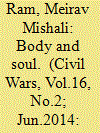

|
|
|
|
|
| Publication |
2014.
|
| Summary/Abstract |
The study presents an integrated model which places the link between the competing state-centric and sub-state explanations of civil strife. As state's capacity and communal fractionalization are typically tested in separate models, the combined framework aims to examine the premise of this article, that communal attributes affect the extent to which state capacity matters in preserving peace and security. The empirical analysis includes 1,385 instances of intrastate conflicts that occurred in 116 countries between 1995 and 2006, drawn from the Major Episodes of Political Violence and the Intra-State War datasets. The results of the study indicate that indeed the weakness of the body is substituted by the strength of the soul: the decline in state authority makes a larger room to sub-state groups, which shape internal dynamics. The second goal of the study is focused on the multifaceted nature of communal traits. Accordingly, the latter part the article offers an actor-oriented analysis, observing the relations between different ethnopolitical groups and violent strife. Based on the qualitative group assessment of the Minorities at Risk project, the study puts to test the argument that not all ethnic groups are alike in their potential to fracture communal solidarity and ignite civil war.
|
|
|
|
|
|
|
|
|
|
|
|
|
|
|
|
| 2 |
ID:
133578
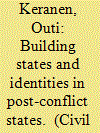

|
|
|
|
|
| Publication |
2014.
|
| Summary/Abstract |
An integral part of state formation processes is identity-building: 'making one out of many' as Walzer puts it. This is also true in terms of contemporary, internationally led statebuilding projects. This dimension of international statebuilding is important, as fundamental questions pertaining to belonging are as important to successful post-conflict process as institutional arrangements; in fact, assumptions about identities and group boundaries guide the technical decisions on institutional and governance structures. The central aim of this paper is to reflect upon identity-construction as a part of post-conflict statebuilding through exploring how historical and more recently invented symbols are deployed to construct a specific sense of belonging. The analysis finds a multiplicity of identity-building projects that advance different visions of community and belonging. The outcome is politicised and contentious visual, everyday landscape that legitimises competing local statebuilding projects (grounded in the distinctions between Bosnian peoples), while undermining peacebuilding and reconciliation. Yet, rather than indicating a primordial antagonisms or incompatible 'liberal' and 'local' norms, the conflicts over symbols (and ultimately, identities) between international and local agents are indicative of wider disagreements over how the Bosnian state ought to be organised and are fuelled by the institutional structures of the country and the weaknesses in the international statebuilding
|
|
|
|
|
|
|
|
|
|
|
|
|
|
|
|
| 3 |
ID:
133581
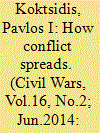

|
|
|
|
|
| Publication |
2014.
|
| Summary/Abstract |
This article examines the escalation of protest mobilization into armed conflict in the Republic of Macedonia (2001). The analysis argues that violence occurred because of a timely collusion between proximate causes and permissive conditions (causes). The state's inherent fragility and the perpetuation of unresolved grievances provided ground for the utilization of opportunity structures by dissident contestants. The study looks into the influence of spillover effects through the lens of contagion and diffusion effects including political radicalization, disputed borderlands refugee flows, and rebel capacity, and provides an assessment of the conditions shaping the decision of the Albanian rebels to use violence. Drawing from a series of elite interviews and documents, the article offers a critical insight into how ethno-regional interdependencies render a largely non-violent conflict susceptible to escalation. The study finds that contagion, disputed borderlands, and the availability of existing operational networks have played a crucial, if not decisive, role in the decision of politically active Albanians in the Republic of Macedonia to use violence.
|
|
|
|
|
|
|
|
|
|
|
|
|
|
|
|
| 4 |
ID:
133577
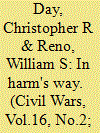

|
|
|
|
|
| Publication |
2014.
|
| Summary/Abstract |
This article explains why contemporary African regimes choose different counter-insurgency strategies and why they tend not to be population-centric. We argue that strategies correspond to the ways in which incumbent regimes in Africa deal with different segments of political society through patronage. Incumbents seek varying levels of accommodation with rebel leaders, or try to eliminate them, according to rebels' historical position within the state. This variation reflects differences in perceived political threats posed to incumbents. We classify these threats as high, moderate or low, which are associated with counter-insurgency strategies of group control, insurgent control and insurgent elimination, respectively.
|
|
|
|
|
|
|
|
|
|
|
|
|
|
|
|
| 5 |
ID:
133582
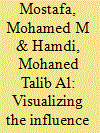

|
|
|
|
|
| Publication |
2014.
|
| Summary/Abstract |
The aim of this paper is to investigate why some internal conflicts are terminated quickly, while others linger for several decades without a looming resolution in the horizon. In an attempt to achieve this objective, the role played by geopolitical factors in the Arab world's internal conflicts was investigated. More specifically, we used Kohonen self-organizing maps, an artificial intelligence-based neural network technique, along with event duration models to investigate the role played by distance from the capital, access to international borders, terrain, valuable natural resources such as oil, and rebels fighting capability in civil wars in the Arab world. Using recently validated data spanning more than 50 years of Arab civil wars (1948-2003), our findings indicate that previously ignored geopolitical factors seem to play an important role in the duration of internal conflicts in the Arab World.
|
|
|
|
|
|
|
|
|
|
|
|
|
|
|
|
| 6 |
ID:
133580
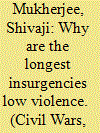

|
|
|
|
|
| Publication |
2014.
|
| Summary/Abstract |
There is a puzzle yet unanswered by theorists of civil war - why are the longest insurgencies low levels of violence? I argue that medium capacity states with multiple insurgencies tend to choose a counter insurgency strategy of containment vis-à-vis peripheral sons of the soil insurgencies, causing them to become stalemated low scale conflicts. While the current literature focuses on commitment problems, or low state capacity to explain such persistent low intensity insurgencies, my theory suggests that central politicians of these medium capacity states try to follow a policy of containment, particularly vis-à-vis the peripheral ethnic 'sons of the soil' insurgencies which are of low priority in terms of threat to political survival of these central politicians. The theory is tested on the Fearon (2004) data-set, and shows that those medium capacity states with multiple conflicts and sons of the soil insurgencies tend to have these low intensity long lasting insurgencies. This paper contributes to the literature on civil war duration, and also to the literature on sons of the soil conflicts. It investigates the different conditions under which state elites do not have sufficient incentives to try and eliminate rebels, because it is unacceptably costly to do so.
|
|
|
|
|
|
|
|
|
|
|
|
|
|
|
|
|
|
|
|
|